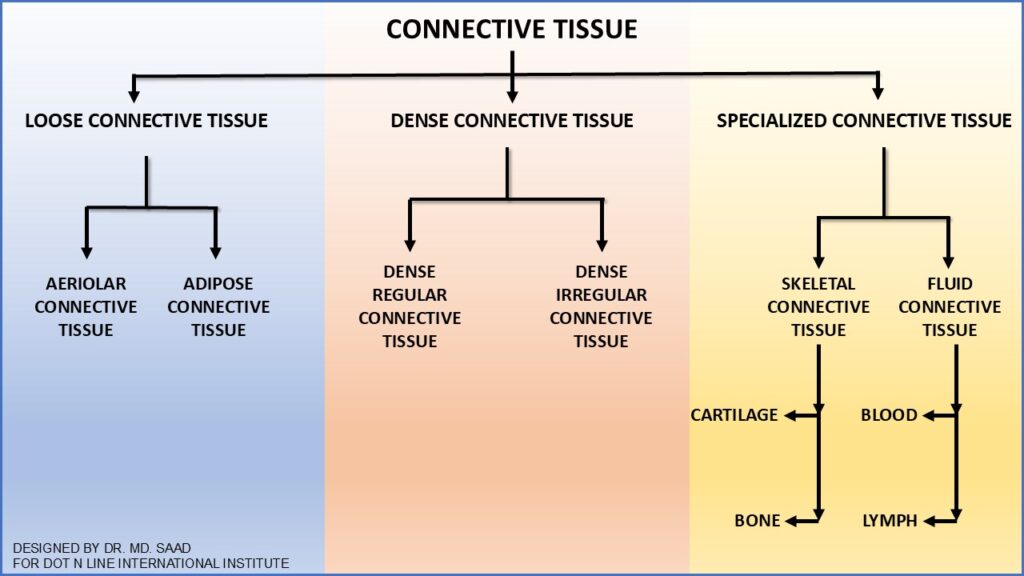(Study Material For DNL Students/ other Paramedical Students)

What is Connective Tissue
Connective tissue is characterized by a significant extracellular matrix that includes fibers (collagen, elastin) and ground substance. This tissue type is found throughout the body, serving as a binding and supporting framework for other tissues and organs. The diversity of connective tissues ranges from loose connective tissue, which provides support and flexibility, to dense connective tissue, which offers strength and rigidity, as well as specialized forms like bone, cartilage, and blood.
Read more
Types of Connective Tissue

- I- Loose Connective Tissue
- II- Dense Connective Tissue
- III- Specialized Connective Tissue
I. Loose Connective Tissue
Loose connective tissue, is characterized by a loose arrangement of fibers (Collagen, Elastin, Reticular) and an abundant ground substance (Extra Cellular Matrix). It serves as a packing material, filling spaces between organs and tissues, and providing support and cushioning. This type of tissue contains various cell types, including fibroblasts, macrophages, and adipocytes.
Function of Loose Connective Tissue
- Serves as Packing Material,
- Fills Spaces between organs and tissues (Fat layer above organs {Adipose Tissue}),
- Provides Support (Bones).
Found at
- under the skin,
- around blood vessels and nerves,
- and in the mucous membranes.
Types of Loose Connective Tissue
- I.i- Aeriolar Connective Tissue
- I.ii- Adipose Connective Tissue
I.i. Aeriolar Tissue
Aeriolar connective tissue is a form of loose connective tissue found beneath the skin. This tissue provides support. There are Fibres and Cells present in the martix of this tissue. The promary cell types of Aeriolar tissue are- Mast Cells, Plasma Calls, Macrophages, Fibroblasts.
I.ii. Adipose Tissue
Adipose tissue is a form of loose connective tissue that stores fat. Adipose tissue is found subcutaneously, around internal organs, and in bone marrow. The primary cell type in adipose tissue is the adipocyte, which accumulates fat in large intracellular vacuoles. This tissue serves as an energy reserve, insulates the body, and provides cushioning and protection for organs.
II. Dense Connective Tissue
Denseconnective tissue, is divided into dense regular and dense irregular connective tissues. Dense regular connective tissue, found in tendons and ligaments, has parallel collagen fibers that provide tensile strength in one direction. Dense irregular connective tissue, found in the dermis of the skin, has an irregular fiber arrangement, offering strength in multiple directions.
III Specialized Connective Tissue
Types of Specialized Connective Tissue
- Skelital Connective Tissue
- Bones
- Cartilage
- Fluid Connective Tissue
- Blood
- Lymph
Blood
Blood is a unique connective tissue with a liquid extracellular matrix called plasma, in which various cell types are suspended, including red blood cells, white blood cells, and platelets. Blood functions to transport oxygen, nutrients, hormones, and waste products throughout the body, regulate temperature and pH, and protect against infections and blood loss through clotting mechanisms. As a connective tissue, blood plays a critical role in maintaining homeostasis and supporting overall bodily functions.
Cartilage
Cartilage is a flexible yet strong connective tissue composed of chondrocytes embedded in a firm extracellular matrix of collagen fibers and proteoglycans. It is avascular, meaning it lacks blood vessels, and relies on diffusion for nutrient and waste exchange. There are three types of cartilage: hyaline cartilage, found in joints and the respiratory tract; elastic cartilage, found in the ear and epiglottis; and fibrocartilage, found in intervertebral discs and the pubic symphysis. Cartilage provides structural support, cushioning, and flexibility.
Bone
Bone, or osseous tissue, is a hard, dense connective tissue that forms the skeletal structure. It consists of osteocytes embedded in a matrix of collagen fibers and mineral salts, primarily calcium phosphate, which provides rigidity and strength. Bone tissue supports and protects organs, facilitates movement by serving as attachment sites for muscles, stores minerals, and houses bone marrow, where blood cells are produced. Bone can be categorized into compact bone, which forms the outer layer, and spongy bone, found inside bones and at the ends of long bones.

The notes are properly arranged and very informative vedio to us.
Thank you.